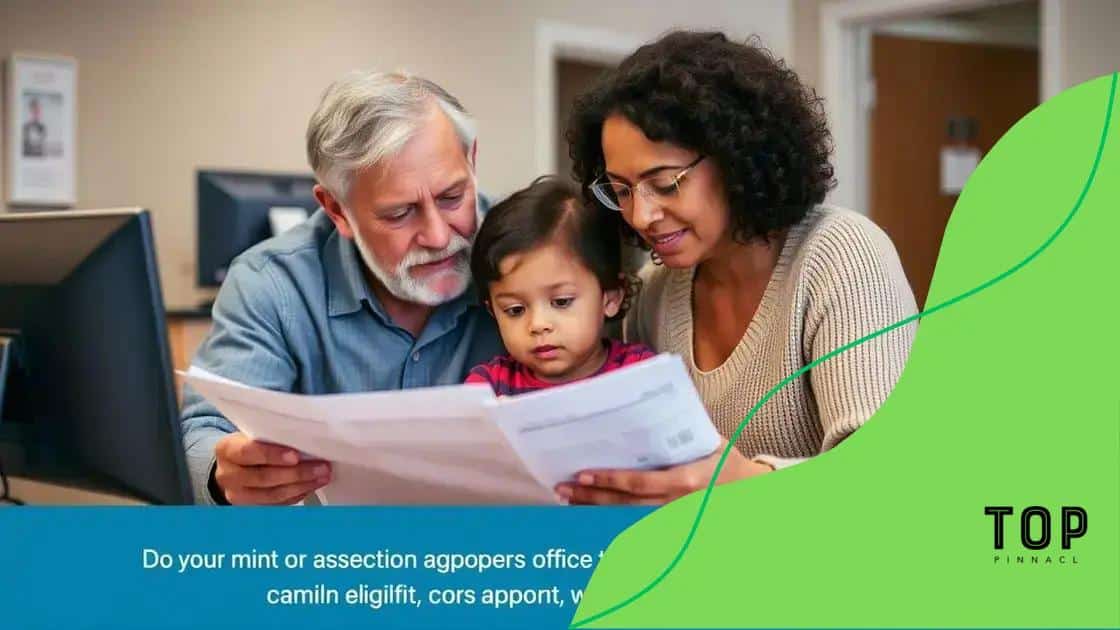Veterans’ survivor benefit modernization: what you need to know
Veterans’ survivor benefit modernization provides essential financial support to eligible family members of veterans, simplifying the application process and improving access to vital resources.
Veterans’ survivor benefit modernization is a crucial topic that affects countless families today. Have you considered how these changes could enhance financial security for those who have sacrificed for our nation? Let’s dive in.
Understanding veterans’ survivor benefits
Understanding veterans’ survivor benefits is important for families who rely on these forms of support. These benefits provide financial assistance to loved ones of veterans who have passed away, ensuring that their sacrifices are honored even after they are gone.
There are different types of survivor benefits available, depending on various factors such as military service and eligibility. Knowing what’s available can help families navigate this often complex system.
Types of Survivor Benefits
Several key benefits exist for survivors of veterans:
- Dependency and Indemnity Compensation (DIC): A monthly benefit for the surviving spouse or children of a service member who died in the line of duty or from a service-related injury.
- Survivor’s Pension: A needs-based benefit for low-income spouses or children of wartime veterans.
- Transition Assistance: Programs that provide support and guidance during the transition from military to civilian life for surviving families.
- Life Insurance Benefits: Insurance payouts that can help families cope with financial loss.
Each benefit has specific eligibility requirements and application processes. Understanding these details helps families maximize the support they receive.
The Application Process
Applying for survivors’ benefits can seem challenging. It often requires gathering various documents, including marriage certificates, death certificates, and military service records. Organization is key to a successful application.
Once submitted, applications are reviewed, and families may need to provide additional information. During this time, staying in communication with the relevant agencies can help clarify any confusing aspects of the process. Families might find it helpful to connect with local veterans’ organizations, as they often offer assistance with applications and provide resources for navigating the benefits system.
Recent changes in survivor benefit policies
Recent changes in survivor benefit policies have made it easier for families to obtain the support they need. These changes reflect a growing recognition of the importance of assisting those who have lost loved ones in military service.
One significant adjustment is the increase in compensation rates. This means that families are now eligible for higher payments, making it easier to cope with financial challenges following a veteran’s death.
Streamlined Application Processes
Another key change is the improvement in application processes, designed to reduce wait times and paperwork burdens. Many families have found the new procedures more straightforward, with online portals offering guided assistance.
- Online Applications: Applicants can now fill out forms online, leading to quicker processing.
- Less Documentation Required: The requirements for supporting documents have been simplified.
- More Personal Assistance: Assistance is available through dedicated representatives to help navigate the application.
These updates focus on easing the burden on families during an already difficult time. Additionally, there has been a push for better communication from the agencies involved, ensuring that families are informed about their benefits.
Expanded Eligibility Criteria
Changes have also expanded the eligibility criteria. More families now qualify for benefits, which is a crucial step toward supporting those who may have previously been overlooked.
For instance, under the new policies, certain conditions have been relaxed, allowing grandchildren or extended family members to claim survivor benefits in specific situations. This adjustment recognizes the diverse family structures that exist today and aims to ensure that all who may need support can obtain it.
As these policies continue to evolve, it remains essential for families to stay informed about their rights and options regarding survivor benefits. Connecting with local veterans’ organizations can provide valuable resources on the latest changes and how they might affect eligibility and benefits.
Eligibility criteria for beneficiaries

Eligibility criteria for beneficiaries of veterans’ survivor benefits can vary based on several factors. Understanding these criteria is crucial for families seeking assistance after the loss of a veteran.
Generally, benefits are available to spouses, children, and sometimes parents of veterans. The specific conditions and required documents will determine who qualifies for the different types of benefits.
Spouses
To qualify as a beneficiary, spouses must often provide proof of marriage. This can include:
- Marriage certificate: This document verifies the marital relationship with the veteran.
- Evidence of cohabitation: Proof that the couple lived together during the marriage.
- Legal separation documents: If applicable, these may clarify the status during the time of the veteran’s death.
Spousal benefits provide essential financial support, making it important for the surviving spouse to understand their eligibility.
Children
Children of veterans may also receive benefits. The eligibility requirements for children include:
- Age limits: Children must typically be under a certain age, often 18 or 23 if attending school.
- Dependency status: Being dependent on the veteran at the time of death, which may require proof of financial support.
- Proof of relationship: This usually involves a birth certificate or adoption papers.
These criteria ensure that the support goes to those who truly need it, particularly young family members.
In the case of parents, eligibility may depend on financial dependency on the veteran, and specific documentation is necessary to prove this connection.
Understanding these eligibility criteria is vital for families to ensure they can access the support designed for them. Families are encouraged to gather all necessary documents and consult with veterans’ organizations for assistance.
Steps to apply for modernization benefits
Applying for modernization benefits can seem daunting, but breaking it down into manageable steps can help simplify the process. Families need to be prepared and understand the application journey ahead.
The first step is gathering all necessary documentation. This includes essential records such as the veteran’s military discharge paperwork, proof of marriage, and any relevant financial information. Having these documents organized and ready can significantly speed up the application.
Online Application Portals
Most applications can now be submitted online, providing a convenient option for many families. Following these steps can simplify the online application:
- Visit the official website: Access the site dedicated to veterans’ benefits for the most accurate information and application forms.
- Create an account: Setting up an account will allow applicants to track their application status and receive updates.
- Complete the application: Fill out the online forms carefully, ensuring that all information is accurate.
As you fill out the application, be mindful of the required fields and double-check for errors, as these can cause delays.
Submitting Supporting Documents
After completing the application, families will need to submit supporting documents. This step is critical, as missing paperwork can hinder eligibility. Make sure to:
- Upload scanned copies: Ensure all documents are clearly scanned and legible.
- Use the correct format: Follow the guidelines for file types and sizes as specified by the application portal.
Once submitted, it’s important to monitor your application progress. Families can log in to their accounts for updates or contact support if there are questions about the status.
Patience is key during this process, as approvals can take time. It’s also beneficial to connect with local veterans’ support groups, which can offer assistance throughout the application process.
Challenges and solutions in the application process
The application process for veterans’ survivor benefits can come with several challenges. Understanding these obstacles is vital for families looking to obtain support after their loss. Knowing what to expect and how to overcome these hurdles can make a significant difference.
One common challenge applicants face is the complexity of the required documentation. Families often need to gather numerous documents, which can feel overwhelming. Having a complete checklist can help simplify this step.
Common Challenges
Some typical challenges include:
- Lengthy Wait Times: Many families report long processing times for application approvals.
- Incomplete Applications: Missing information or documents can lead to delays.
- Confusing Guidelines: The rules governing eligibility and benefits can be hard to understand.
Recognizing these obstacles is the first step in preparing to face them.
Solutions to Overcome Challenges
While challenges can make the process frustrating, there are several solutions to help navigate the application effectively:
- Stay Organized: Keep all documents neat and accessible. A checklist can help ensure nothing is missed.
- Use Online Resources: Many veterans’ organizations provide guides and support, helping families understand the process better.
- Contact a Veteran’s Representative: Speaking with someone who understands the system can clarify confusing points and provide guidance on what to include in your application.
- Regularly Check Application Status: Following up can help identify any issues early on, preventing further delays.
These strategies can significantly improve the chances of a smooth application experience. Families should remember that finding support through local veterans’ organizations and community resources can also help ease the burden during this challenging time.
Conclusion:
Navigating the process of applying for veterans’ survivor benefits can be complex, but knowing the steps to take can make it easier. Understanding eligibility criteria and being organized when gathering documents is key. Families should utilize available resources and seek support to overcome challenges. By staying informed, proactive, and connected, applicants can ensure they receive the benefits that honor their loved ones’ sacrifices.
FAQ – Frequently Asked Questions about Veterans’ Survivor Benefits
What are veterans’ survivor benefits?
They are financial supports provided to the family members of veterans who have passed away, aiming to help them cope with the loss.
Who is eligible for survivor benefits?
Typically, spouses, children, and sometimes parents of veterans are eligible, depending on various factors.
How can I apply for modernization benefits?
You can apply online by gathering the required documents and submitting them through a designated veterans’ benefits portal.
What challenges might I face in the application process?
Common challenges include lengthy wait times, incomplete applications, and difficulty understanding the eligibility criteria.






